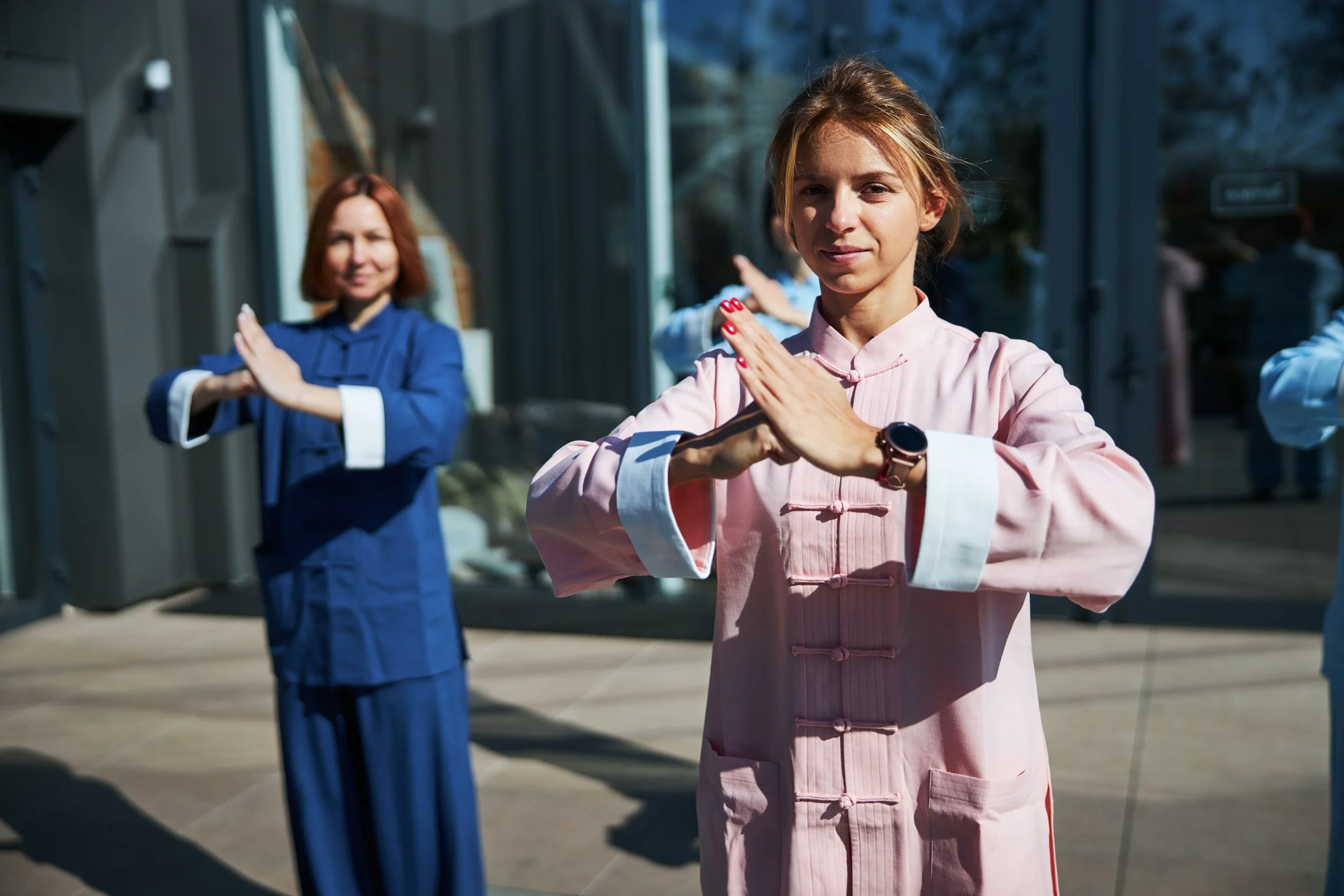Qigong
Qigong has been used to promote healing in all aspects of human experience - physical, mental, and emotional. It is a holistic approach to health that recognizes the interconnectedness of all parts of the human experience.
Embarking on the path of holistic wellness through QiGong is a transformative step towards enhanced well-being.
With the Healers & Teachers app, you gain access to a wealth of resources, experienced practitioners, and a supportive community
Qigong is an ancient Chinese practice that has been around for thousands of years. Its origins can be traced back to the early days of traditional Chinese medicine, when healers and practitioners began to develop exercises and techniques for improving physical, mental, and spiritual health.
The term "Qigong" itself is made up of two Chinese words: "qi" (sometimes spelled "chi"), which means energy or life force, and "gong", which means work or cultivation. Qigong is therefore a practice that involves working with and cultivating one's life force energy.
There are many different styles and approaches to Qigong, each with its own unique history and lineage. Some styles are rooted in Taoism or Buddhism, while others draw from traditional Chinese medicine or martial arts.
Healing of Mind, Body, and Spirit
In modern times, Qigong has gained popularity as a complementary therapy for a wide range of health conditions. The practice involves slow, deliberate movements, deep breathing, and meditation, all of which help to improve physical, mental, and emotional wellbeing.
Physical Healing: Qigong can help to improve physical health by reducing stress, improving circulation, and boosting the immune system. It can be used to alleviate pain and improve mobility in people with conditions such as arthritis, fibromyalgia, and chronic fatigue syndrome. Additionally, it has been shown to improve the symptoms of respiratory conditions such as asthma and allergies.
Mental Healing: The practice of Qigong can help to improve mental health by reducing stress and anxiety, improving focus and concentration, and promoting feelings of calm and relaxation. It can also be used to alleviate symptoms of depression and PTSD.
Emotional Healing: Qigong can help to improve emotional wellbeing by promoting a sense of inner peace and calm. It can be used to reduce feelings of anger, frustration, and anxiety, and to promote a greater sense of emotional balance and stability.
Benefits to Modern Daily Lives
In today's fast-paced world, many people are looking for ways to improve their health and wellbeing. Qigong offers a simple, effective, and accessible way to achieve these goals. Some of the benefits of practicing Qigong in modern daily life include:
Reduced stress and anxiety: The slow, gentle movements and deep breathing of Qigong help to reduce stress and anxiety, promoting a greater sense of calm and relaxation.
Improved physical health: Qigong can help to improve physical health by reducing pain and inflammation, improving circulation, and boosting the immune system.
Enhanced mental clarity: The practice of Qigong can help to improve focus and concentration, promoting a greater sense of mental clarity and alertness.
Greater emotional balance: Qigong can help to promote a greater sense of emotional balance and stability, reducing feelings of anger, frustration, and anxiety.
How does Qigong work?
Qigong works by balancing and regulating the body's energy system, which is believed to be a vital force that flows through the body and influences physical, mental, and emotional health. According to traditional Chinese medicine, this energy, known as "Qi," flows through the body along channels called "meridians." When the flow of Qi is disrupted or blocked, it can lead to physical, mental, or emotional imbalances, and potentially to illness or disease.
The practice of Qigong involves various techniques to regulate the flow of Qi, including slow, rhythmic movements, deep breathing, visualization, and meditation. These techniques are designed to activate and harmonize the flow of Qi through the meridians, promoting healing and wellbeing.
Qigong is also thought to work by reducing stress and promoting relaxation, which can help to improve immune function, reduce inflammation, and boost overall physical and mental health. Additionally, the practice of Qigong can help to increase awareness and mindfulness, which can promote a greater sense of emotional balance and mental clarity. Overall, Qigong is a holistic practice that addresses the interconnectedness of the mind, body, and spirit to promote health and wellbeing.
What Can I Expect in a Typical Qigong practice?
A typical Qigong practice involves a combination of movements, breathing techniques, meditation, and visualization. While the specific movements and techniques may vary depending on the particular style of Qigong being practiced, the emphasis on slow, flowing movements, deep breathing, and mindfulness is common to all Qigong practices. The practice can be done standing, sitting, or lying down, and can be adapted to different levels of physical ability. Here are some elements that you may expect to encounter in a typical Qigong practice:
Warm-up exercises: Many Qigong practices begin with gentle warm-up exercises, such as loosening and stretching movements, to help prepare the body for the more focused movements to come.
Qigong movements: The core of the practice involves a series of slow, flowing movements that are designed to stimulate the flow of Qi through the meridians. These movements may be performed in a standing position, seated, or lying down.
Breathing techniques: Qigong places a strong emphasis on deep, slow breathing, which helps to activate and regulate the flow of Qi. Specific breathing techniques may be incorporated into the practice, such as "abdominal breathing" or "reverse breathing."
Meditation and visualization: Many Qigong practices incorporate elements of meditation and visualization, which can help to promote relaxation and mental clarity. This may involve focusing the mind on specific parts of the body or visualizing the flow of Qi through the meridians.
Cool-down exercises: At the end of the practice, gentle cool-down exercises may be performed to help bring the body back to a state of balance and relaxation.
Who Might Want to Try Qigong? Are There Any Risks?
Qigong is a safe and gentle practice that can be beneficial for people of all ages and fitness levels. Because it is a low-impact exercise that can be adapted to different levels of physical ability, it is often recommended as a gentle form of exercise for people who may not be able to engage in more strenuous activities.
People who may benefit from trying Qigong include:
Those looking for a low-impact exercise: Qigong is a gentle, low-impact form of exercise that can be practiced by people of all ages and fitness levels.
Those looking to reduce stress: Qigong emphasizes deep breathing, mindfulness, and relaxation, making it an effective practice for reducing stress and promoting a sense of calm.
Those looking to improve balance and coordination: The slow, flowing movements of Qigong can help to improve balance, coordination, and flexibility.
Those looking to cultivate mental clarity: Qigong incorporates elements of meditation and visualization, which can help to promote mental clarity and emotional balance.
Those looking for a complementary therapy: Qigong can be used as a complementary therapy for a variety of health conditions, including chronic pain, anxiety, and depression.
While Qigong is generally safe, there are a few potential risks to be aware of. These may include muscle strain or injury if the movements are not performed correctly, and dizziness or lightheadedness if the breathing techniques are not performed properly. It is always recommended to start slowly, and to work with an experienced teacher who can provide guidance and support as you begin your Qigong practice. As with any new exercise or therapy, it is always a good idea to talk to your healthcare provider before starting Qigong, especially if you have any underlying health conditions or concerns.
Healing and Growth begins with you
Remember, the path to holistic health and inner harmony is personal, and having a supportive community by your side can be empowering. With the Healers & Teachers app, you'll have a wealth of resources and a supportive community right at your fingertips, ready to assist you every step of the way.
The Healers & Teachers app offers:
Access to diverse practitioners specializing in Qigong who can provide personalized guidance tailored to your unique needs and goals.
A range of services, including one-on-one consultations, group classes, workshops, and specific wellness practices, along with educational events and webinars.
A nurturing and supportive community where you can connect with others, share experiences, ask questions, and learn from collective wisdom.









